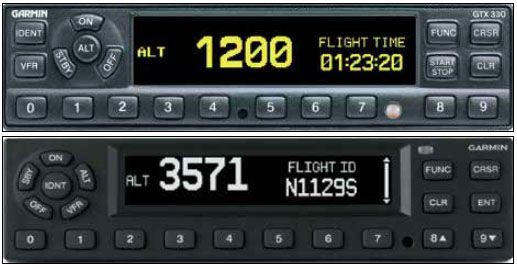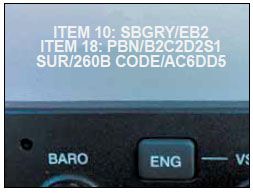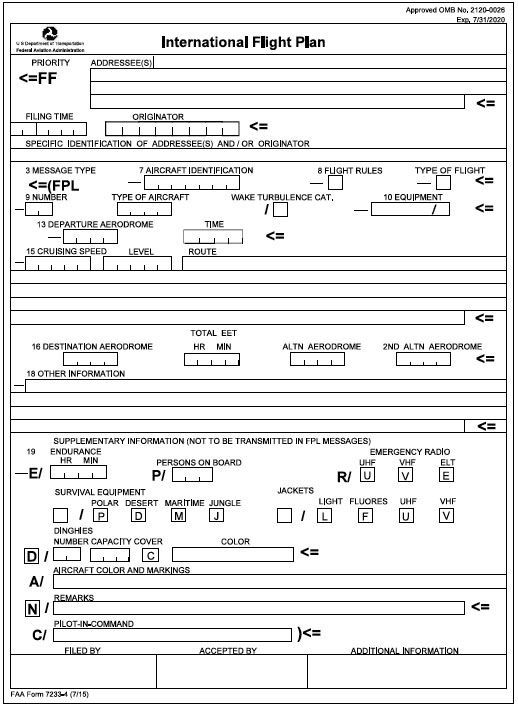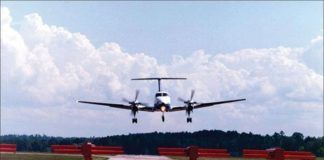August 2019, marked the end of the FAA Domestic Flight Plan. The ICAO Flight Plan form is required in the U.S. for all VFR and IFR flights. Yet, there are two areas that still create confusion: Item 10. Equipment, and Item 18, Other Information.
Many pilots struggle with these codes and ask: 1.) Does ATC care about the codes? 2.) Are some codes redundant and/or superfluous? 3.) Is there “nesting” (something that is included in a bigger part)? 4.) Who are the customers of the ICAO flight plan?
Equipment vs. Capabilities
Pre-GPS, it was easy to look at an instrument panel and determine the installed equipment. A typically well-equipped IFR light general aviation airplane would have dual NAV/COMs, Mode C transponder, maybe an ADF and possibly a DME. With the arrival of GPS and glass panels with remote installed avionics such as LRUs (line replaceable units), matters got more complicated.
It became challenging to know what avionics were installed. Furthermore, not all GPS navigators were created equal; they had different levels of capabilities. Additionally, due to advances in avionics in airliners, the focus is on “avionics capabilities” rather than “installed equipment” especially with multi-sensor FMSes (flight management systems) that combine several devices and functions in one system, such as inertial reference unit (IRU), VOR, DME, and GPS, all working as an integrated unit.
Let’s take an example of what we face with capabilities. With a VHF comm radio (equipment), we can communicate via voice with ATC, Unicom and other aircraft (capability). I can say a similar thing with ADF (equipment) means that we have the capability to home-in on a NDB. We need to mentally transition to capabilities even though, at first glance, it might sound nonsensical because equipment implies capabilities and vice-versa. As we go forward, our avionics lexicon needs to include “capabilities.”
Mode C and S Transponders
Let’s review types of transponders since the codes appear to cause some confusion: Transponder Type and Surveillance or ADS-B. These codes go in Item 10 after the “/”.
There are two main types of transponders we use: Mode C and Mode S (S for select interrogation). Mode S technology was developed by MIT’s Lincoln Labs in the 1970s to allow a new emerging technology: TCAS (traffic collision avoidance system) that allowed airplane-to-airplane communication and provided traffic information among participating aircraft. TCAS even provided information to pilots on what to do, like climb or descend. This RA (resolution advisory) is reserved for the big boys and isn’t in our active traffic systems (called TAS, traffic advisory system). Instead, we typically get a visual cue on a display and we hear “traffic” as audio.
(Keep in mind that TAS is only good to start looking for traffic in the appropriate direction, it is not meant to take evasive action without visual contact. Only when the traffic is in sight, should pilots take action. AIM 4-5-8)
Extended Squitter (ES)
The technology that’s added to a Mode S transponder for ADS-B Out is called extended squitter. But there is a much more important difference between Mode C and S vs. Mode S-ES. All transponders respond to interrogations from ATC radar and other airplanes; the response is the familiar squawk. Mode S-ES goes a step further—it also transmits about once every second (a squit) without interrogation. ATC Center radar updates your position every 20 seconds. With ADS-B Out the aircraft position is updated more frequently and with more precision since the squit provides LAT/LON position from an airborne WAAS GPS source. This is expected to enable closer spacing to increase the capacity of the National Airspace System (NAS).

ICAO Transponder Codes
In Item 10, two pieces of information follow the “/”—the type of transponder and how ADS-B Out is achieved.
The transponder code choices are C (Mode C), S (Mode S), and E (Mode S with extended squitter). ADS-B Out can be from extended squitter or (in the U.S. only and below FL180) through a separate UAT (Universal Access Transceiver) that operates on a different frequency. Additionally, a UAT usually provides ADS-B In (weather and traffic) but a display is needed.
So, in the U.S., most of us will use one of the following codes.
CU1 or CU2: If you have only a Mode C transponder, your ADS-B will have to come from a UAT. U1 means your UAT is out only or has no certified display for ADS-B In. U2 indicates you have ADS-B Out and In via a panel- mount display. Reality: ATC doesn’t care if you have ADS-B In.
SU1 or SU2: Again, if you have only a Mode S transponder, your ADS-B will have to come from a UAT. U1 and U2 are as above.
EB1 or EB2: You have ADS-B out via a Mode S transponder with extended squitter. B1 and B2 are like U1 and U2 above, but your data is received on the transponder frequency. Note: It’s possible for an EB2 installation to also receive data on the UAT frequency.
What about codes /B1, /CB2 and / EU1? /B1 does not specify a transponder type, but the only option is E. CB2 is invalid because a Mode C transponder doesn’t have extended squitter. The same would be true with SB2; a basic Mode S transponder does not have extended squitter. EU1 or EU2 are possible but rare—a Mode S-ES transponder with a UAT. One of the two “Outs” would have to be disabled. This could be the case when a UAT unit was installed to receive ADS-B In data in an airplane with an existing Mode S-ES transponder with no “In” capability.
Today, most new transponders are Mode S-ES with ADS-B Out and In and have the capability to display the data on a panel-mount display or wirelessly to a tablet.
ITEM 10 Before the “/”
Equipment codes are much more obvious. But to put this in proper perspective let’s consider the following avionics as typical: Garmin GTN 6xx/7xx, GNS 4xxW/5xxW and G1000W. The equipment codes exclusive of transponder codes are: SBGRY/.
S VHF COMM, VOR, and ILS. If any of the three are missing, then you must identify them separately: V (VHF COMM), O (VOR) and L (ILS).
BG IFR GPS with LPV (Implying SBAS—Satellite Based Augmentation System, known as WAAS in the U.S.) Note: B cannot stand alone, needs to be associated with GPS.
R a pointer code meaning information on Performance Based Navigation (PBN) is in ITEM 18. More later.
Y Means that the VHF COMM can handle 8.33kHz channel spacing, effectively quadrupling the channels compared to the 760 channel radios with 25 kHz spacing.
The Y code is an example of a superfluous code in the U.S. since the U.S. does not use 8.33 kHz spacing; it only applies to certain European airspace.
If you happen to have a DME add D and an ADF add an F. Additionally, there are other avionics that are not coded like marker beacon receiver, radar altimeter and autopilot.
Item 18 Other Information

To fully understand Performance Based Navigation, it’s best to quote AIM 1-2- 1: “Within PBN there are two main categories of navigation methods or specifications: area navigation (RNAV) and required navigation performance (RNP). In this context, the term RNAV x means a navigation specification with a specified lateral accuracy value. For an aircraft to meet the requirements of PBN, a specified RNAV or RNP accuracy (within x NM) must be met 95 percent of the flight time. RNP is a PBN system that includes onboard performance monitoring and alerting capability (for example, Receiver Autonomous Integrity Monitoring (RAIM)).” For our smaller aicraft, RNAV implies WAAS GPS; there are other options beyond the scope of this article.
For the avionics above, the codes would be PBN/A1B2C2D2L1O2S1 (Source Garmin Equipment RNAV and RNP Capabilities spreadsheet).
Let’s peel the onion.
A1 RNAV-10 Oceanic (Ref AC 90- 105A)
B2 RNAV-5 GNSS (ICAO term for GPS) (Ref AC 90-96A CHG1)
C2 RNAV-2 GNSS (Ref AC 90-100A CHG 2)
D2 RNAV-1 GNSS (Ref AC 90-100A CHG2)
L1 RNP-4 Oceanic (Ref AC 90-105A)
O2 Basic RNP 1 GNSS (Ref AC 90- 105A)
S1 RNP Approach (Ref AC 90-105A) (Actually RNP-.3)
It’s probably not necessary to use A1 if the navigator can do RNAV-1, it can do RNAV-10—the nesting issue. L1 and O1 are RNP specifications not usually required in the U.S. However S1 is an RNP specification that requires WAAS (fault detection and exclusion) for GPS approaches to LPV, LP and LNAV/ VNAV without baro aiding.
This leaves us with PBN/B2C2D2S1. We can see the difference between Equipment Codes and PBN Codes. For example, “BG” equipment is a WAAS GPS capable of flying to LPV, LP and LNAV/VNAV minimums, but isn’t that S1 capability and maybe redundant? But, RNAV-2 is required for T and Q routes, RNAV-1 for RNAV SIDs and STARs. S1 is required for the final approach segment flown to LPV, LP, or LNAV/VNAV minimums.
In Item 18, there are other codes that could be included. One is the Mode S Hexadecimal Code that is part of an aircraft’s registration certificate by encoding the tail number and it is part of configuring a Mode S transponder. The codes are in the FAA Aircraft Registry database. Hexadecimal codes are shown as CODE/XXXXXX in 18.
Another one is the ADS-B Out RTCA (Radio Technical Commission for Aeronautics) standards. SUR/260B for extended squitter and SUR/282B for UAT. (RTCA DO-260B and DO-282B, respectively.) Not sure how critical this is since we hope that the installed equipment meets relevant standards.
Last, there is one code that is important when applicable. If we fly with an organization call sign (e.g. CAPXXX for Civil Air Patrol), or a type of flight (e.g. Lifeguard or Safety One when the FAA Administrator is on board), we need to put the tail number on ITEM 18: REG/NXXXX.
Conclusions
In part based on informal, anecdotal discussions with ATC and FSS specialists, I’ve concluded the following.
- For the majority of light, general aviation airplanes flown in IFR in the U.S.: Item 10: SBGR/Transponder C, S or ES type and ADS-B equipment Ux or Bx. In ITEM 18: PBN/B2D2C2S1, CODE/XXXXX
- PBN codes don’t really matter for VFR flight plans, but transponder and ADS-B codes do.
- For IFR, ATC does care about the PBN codes and can determine what airspace and procedures an airplane can fly.
- Other than ATC, a key customer of the flight plan is, believe it or not, the PIC. If the PIC is also the airplane owner, we would hope that he/she knows what equipment is installed but even that’s not always the case. The issue is perhaps more with rental or club aircraft where equipment might vary among airplanes and isn’t necessarily obvious by peeking at the panel. There is a simple answer, place a placard on the panel with the codes.
- Don’t depend on avionics shops to provide the codes. The first place to look for capabilities (not the actual codes) would be in the POH Avionics Supplements which are regulatory. The capabilities might be stated indirectly by making reference to relevant Advisory Circulars.
- Since most of us store airplane profiles in an aviation app and file flight plans electronically, store all applicable codes even if some might not be relevant for a particular flight. Long gone are the days we would walk into one of the many Flight Service Stations scattered across the country, get a weather briefing, fill out a paper flight plan and hand it over to a Specialist who would correct the mistakes. If nothing else, it’d be quite a challenge to remember all the codes.






I’m still as lost as last year’s Easter egg.
Has anyone made an app or something where I can enter the equipment in the plane and have it spit out what I need to put as my codes?